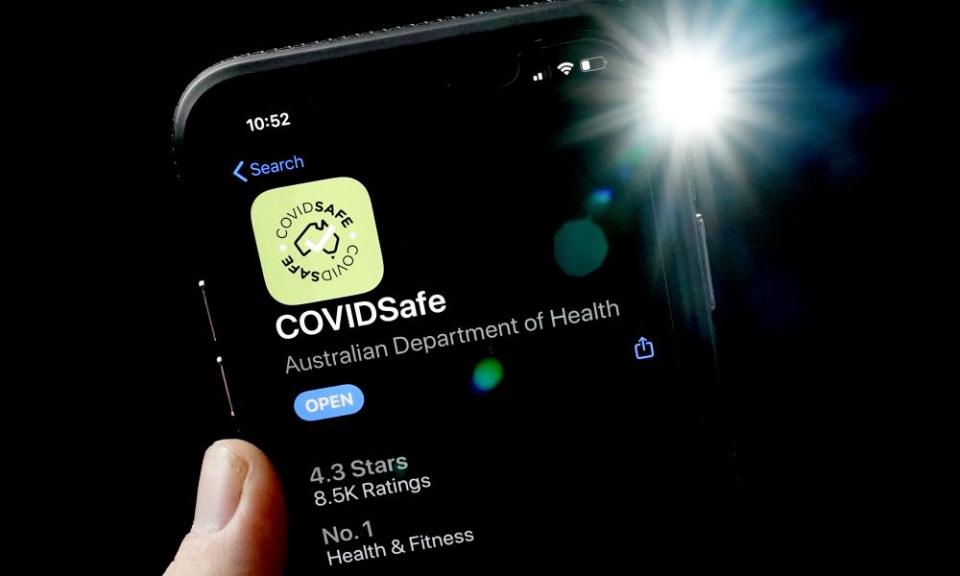‘A lemon’: Coalition fights to keep Covidsafe app data under wraps

Morrison government says it is negotiating with the states about future uses for application
The Morrison government insists it is negotiating with the states about “future uses” for its troubled Covidsafe app despite it not being used during the outbreaks that prompted lockdowns in Victoria, New South Wales and the Australian Capital Territory.
The government is also refusing to release how many Australians continue to use the app, with one tech expert accusing the government of trying to avoid disclosing embarrassing data rather than admit it had failed to achieve its purpose.
Since vaccination rates reached more than 90% of the eligible population in most states, contact tracing is slowly being scaled back, with health authorities limiting the number of people contacted and asked to test and isolate.
Related: Australian conspiracy theorists and anti-lockdown groups share fake Covid check-in apps
Even when contact tracing played a critical role in reducing the number of cases, the app was of little assistance.
Almost none of the contacts were identified through the federal government’s CovidSafe contact tracing app despite well over 7 million people in Australia downloading it last year and the prime minister, Scott Morrison, declaring it the ticket out of lockdown.
Since launching in April last year, just 17 “close contacts” in NSW were found directly through the app that were not otherwise identified through manual contact tracing methods.
Guardian Australia has been engaged in a year-long freedom of information battle with the Digital Transformation Agency to reveal how many people continued to use the app after installing it.
This month the agency said releasing the information would hurt negotiations with the states over the app’s future uses.
“The Commonwealth is engaged in ongoing consultations and discussions with the states and territories on a framework around the use of Covidsafe data and data derived from Covidsafe data as a key tool for contact tracing,” DTA’s chief technology officer, Anthony Warnock, told the Office of the Australian Information Commissioner in a letter provided to Guardian Australia.
When asked about these discussions, both NSW and Victoria said the app had not been used at all in 2021.
“To date, it has not been necessary to use the Covidsafe app with any case clusters in 2021,” a NSW Health spokesperson said. “NSW Health’s contact tracing team has access to a variety of information to contain the spread of Covid-19 and keep the community safe.”
Related: States introduce tougher border rules as Scott Morrison urges them to ‘not get spooked’ by Omicron
The ACT also said the app had never been used in the capital and, as of September, Queensland said it had used the app twice, with one contact identified but no positive cases identified.
It’s also unclear what future uses the federal government is considering.
Electronic Frontiers Australia’s chair, Justin Warren, who has been involved in complex FOI battles with the government, suggested the only reason the the release of the information would be damaging was if it showed far fewer people continued to use the app.
“The DTA appears to be trying to argue that we can’t learn the truth about just how big a lemon the Covidsafe app is because then people might know it’s a lemon and act accordingly,” he said. “It’s clear to me that they wouldn’t try to make this argument if the app was useful.”
The app costs around $75,000 a month to run, and a spokesperson for the federal health department said there were “no plans” to shut it down until the health minister determined it was no longer required.
Experts in the tech community last year called for the app to be modified using the Apple-Google exposure notification framework, which would work similarly to the UK’s NHS app and alert people when they had been in contact with a confirmed Covid-19 case.
A study published in Nature in May about how effective the NHS app in England and Wales had been between September and December last year found that for every positive case who agreed to alert their contacts, one case was averted.
The government has long argued against switching to an NHS-style version of the app, arguing that it left it up to users to contact the health department and get tested and isolate, rather than giving contact tracers a list of those exposed to follow up.
But a ministerial brief prepared by the DTA in May 2020, released this week on the transparency website Right to Know, reveals that the government believed it would require massive changes to the app and privacy laws to accommodate the change.
“The app would need to be significantly redesigned and rebuilt,” the agency said. “The ENF cannot simply be embedded into the current app. The health portal would also need to be redesigned and rebuilt.”
The DTA warned that a new privacy assessment would need to be undertaken, legislation might need to be amended, all current users would need to download and re-register through the app, and contact data could not be transferred.
The briefing also noted that the alerts people received through the app “may cause alarm” if contact tracers were not involved in the process.
But the agency said a change to the Apple/Google version would improve connectivity between devices and might encourage people who had hesitated to download the original app.
“Certain users who have avoided the app may perceive that the ENF provides stronger privacy protections through this largely decentralised non-government-controlled model.”
Victoria now automatically alerts people who were at high-risk venues through the Service Victoria app, and advises them to test and isolate, but does not do any further contact tracing except when someone tests positive.
NSW is planning to ditch QR code check-ins from all but high-risk venues from 15 December, or when the state reaches 95% of the eligible population having two doses of the vaccine.

 Yahoo Movies
Yahoo Movies 